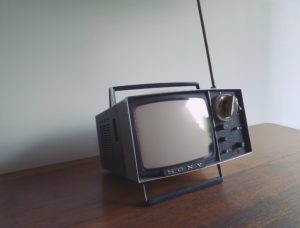“The luminous screen in the home carries fantastic authority,” radio and TV historian Erik Barnouw writes. “Viewers everywhere tend to accept it as a window on the world… It has tended to displace or overwhelm other influences such as newspapers, school, church, grandpa, grandma. It has become the definer and transmitter of society’s values.” It’s not just the camera passively transmitting visual and auditory data. The very invention of television required human performance.
This might explain why the earliest TV broadcasts, including experimental ones, featured theatrical productions rather than, say, nature shots or people just standing around and talking. The journey begins with WGY, a Schenectady, New York radio station with a long and important history. Although it’s a Clear Channel station now, in 1903 (119 years ago) the station was a licensee of General Electric, who had contracted with inventors and researchers to develop high-frequency stations. A few years later, the station was also broadcasting television signals, as were experimenters around the world. By the 1930s, a limited amount and type of commercial programming was available.
Theatrical and cinematic performance were a driving force behind television content production. A 1928 article reads: On September 11, 1928, WGY, the first station to organize a dramatic group and present plays regularly to the radio audience, established itself also as the first station, anywhere, to broadcast an actual drama with the aid of television: transmitting images and voice simultaneously on separate radio channels . . . It was highly effective, and held the attention and interest of the rather critical audience as closely as if it had been the highest-priced dramatic hit on broadway.”

That’s the thing with TV–you need to be performing something, being active, creating a spectacle of some kind, in order to justify being telecast. Even the reality TV of the present time, seemingly showing non-actors in real life situations, is performative.
Another obvious performative subject matter for early television was sports. In 1937 the Wimbledon tennis tournament was broadcast on live television, announcers explaining the difficult nature of the project. In 1939, live baseball games were televised from Columbia University.
And then there was news. By the end of the 1930s, networks like NBC had started to simulcast some of their content on radio and television simultaneously. Keep in mind that TVs would not become household necessities for a few more years yet. But in 1940, famous news pioneer Lowell Thomas began simulcasting the news regularly, every weeknight. Initially, the telecast was only seen in New York City, on the WNBT channel. During the Second World War, production of television sets stopped, but the war itself became a subject of broadcasting for somewhat serendipitous reasons: RCA had been developing cameras for bombers to help remotely guided glide bombers reach their targets. The cameras didn’t work very well that way, but the technology helped shape remote broadcasts from various war sites. And so war itself, already well-established as a spectacle, became a spectacle capable of reaching, and affecting, the masses. Television is about affect as well as effect.